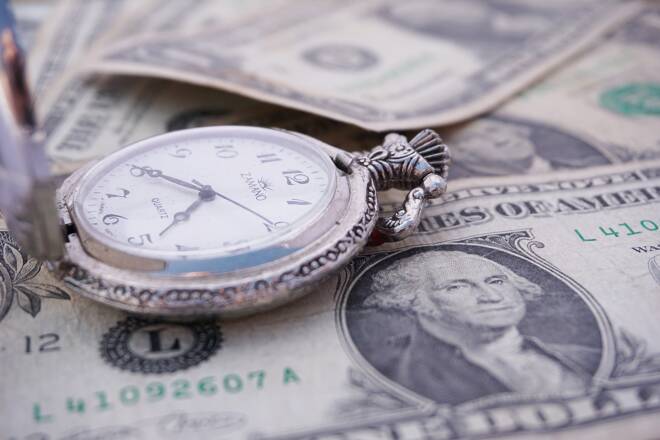Advertisement
Advertisement
Tax Reform Concerns Stop U.S. Dollar Rally
By:
The bullish bubble may have burst last week for the U.S. Dollar after the lack of clarity over U.S. tax reform raised issues about the aggressiveness of
The bullish bubble may have burst last week for the U.S. Dollar after the lack of clarity over U.S. tax reform raised issues about the aggressiveness of the Fed in raising rates in 2018 and 2019, driving down U.S. Treasury yields and encouraging investors to book profits in the stock market.
December U.S. Dollar Index futures finished the week at 94.278, down 0.580 or -0.61%.
The weakness in the dollar was spread almost evenly amongst the major currencies. The Japanese Yen rose 0.46%, the Australian Dollar increased 0.09%, the New Zealand Dollar was up 0.28%, the Euro posted a 0.46% gains and the British Pound gained 0.89%.
There were no major U.S. economic reports last week but with a rate hike in December a done deal, the focus was likely to be on tax reform anyway. The key story last week played out this way.
Disappointment with a tax bill put forth by U.S. Senate Republicans that would delay corporate tax cuts dominated the trade in all asset classes late last week. Risky assets such as the U.S. Dollar and U.S. equity markets lost ground while money flowed into safe haven assets such as gold and the Japanese Yen. The tone set on the weekly charts suggests the story may linger for some time.
According to CNBC, the Senate Republican’s bill to rewrite the tax code differed from their House counterparts’ plan. Like the House version, the Senate’s proposal would cut the corporate tax rate to 20 percent from 35 percent, but the Senate plan would delay implementation until 2019.
The politicians suggest this process is normal, however, the market action suggests investors want clarity.
Additionally, both plans call for a tax on $2.6 trillion in foreign profits held offshore by U.S. multinationals. The Senate wants that tax to be 12 percent for cash and liquid assets, and 5 percent for non-liquid assets. The House amended its bill on Thursday, going to 14 percent and 7 percent respectively.
Furthermore, both bills would add $1.5 trillion over 10 years to the U.S. budget deficit and national debt, which in the past would likely have faced criticism from Republicans.
USD/JPY
After posting a strong gain the previous week, the Dollar/Yen was poised to surge to the upside last week if enough buyers came in to drive the Forex pair through the recent top at 114.443. The breakout took place on Monday, but the buying dried up at 114.728 after uncertainty around tax plan progress began to surface and the Treasury bond market started flashing a warning sign about a recession. Buyers never regained control and the Dollar/Yen closed lower for the week.
The USD/JPY settled at 113.513, down 0.519 or -0.46%.
AUD/USD
Despite a mostly sideways trade on the daily chart, the Australian Dollar still managed to eke out a small weekly gain.
The AUD/USD settled at .7656, up 0.007 or +0.09%.
Early in the week, the Reserve Bank of Australia left its benchmark interest rate unchanged at 1.50%. Later in the week, the RBA slightly downgraded its outlook for economic growth in Australia while signaling only a gradual rise in headline inflation.
In its quarterly statement on monetary policy, the central bank said it sees growth in December 2017 of 2.5 percent easing back from 2 to 3 percent in the previous forecast issued in August.
Additionally, in December 2018, the RBA sees economic growth of 3.25 percent, down from a previously forecast peak of 3.75 percent.
The RBA also forecast the economy growing at “a solid pace” over the next few years due positive labor market developments. However, the RBA is more concerned about inflation and wages growth with the central bank warning that both will rise “only gradually over time”.
Due to the weaker outlook for rising inflation, the Reserve Bank will leave its cash rate on hold at the historic low of 1.5 percent indefinitely.
NZD/USD
Oversold technical conditions and a weaker U.S. Dollar underpinned the New Zealand Dollar most of the week.
The NZD/USD settled at .6926, up 0.0020 or +0.28%.
The Reserve Bank left the Official Cash Rate on hold at 1.75%, as widely expected.
Acting Governor Grant Spencer reiterated the same message the RBNZ had been giving all year; the housing market is cooling, inflation is muted and the economy is steadily improving.
“Global economic growth continues to improve, although inflation and wage outcomes remain subdued,” Mr. Spencer’s statement said.
“Annual CPI inflation was 1.9 percent in September although underlying inflation remains subdued. Overall, CPI inflation is projected to remain near the midpoint of the target range and longer-term inflation expectations are well anchored at 2 percent.”
Finally, the RBNZ left its policy statement intact. “Monetary policy will remain accommodative for a considerable period. Numerous uncertainties remain and policy may need to adjust accordingly.”
About the Author
James Hyerczykauthor
James Hyerczyk is a U.S. based seasoned technical analyst and educator with over 40 years of experience in market analysis and trading, specializing in chart patterns and price movement. He is the author of two books on technical analysis and has a background in both futures and stock markets.
Did you find this article useful?
Latest news and analysis
Advertisement
